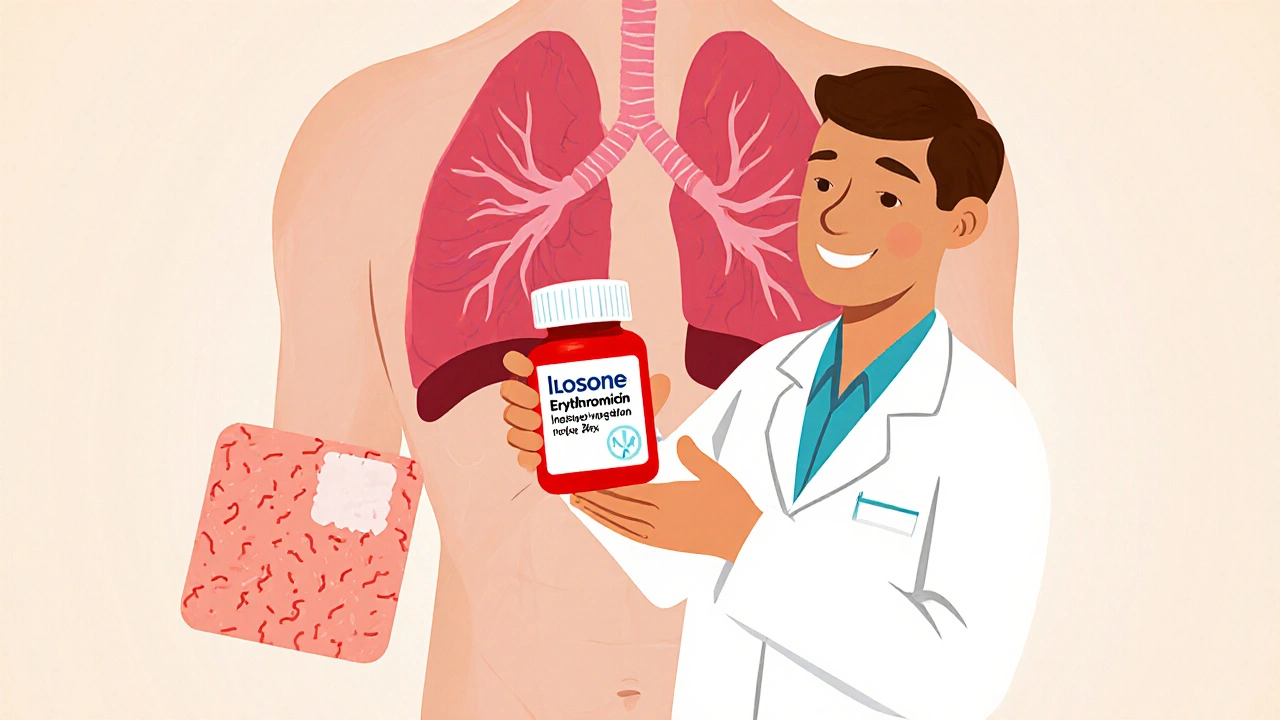
When you search for Ilosone alternatives, you’re probably wondering whether another pill will work better, cost less, or cause fewer side effects. This guide breaks down Ilosone (erythromycin) and compares it head‑to‑head with the most common substitutes you’ll see on a prescription pad.
Ilosone is a brand name for erythromycin, a macrolide antibiotic that inhibits bacterial protein synthesis by binding to the 50S ribosomal subunit. It’s been on the market since the 1950s and remains a go‑to choice for patients who can’t tolerate newer macrolides. The drug is available as tablets, capsules, and a liquid suspension, making it suitable for adults and children.
Erythromycin blocks the translocation step of protein elongation, effectively freezing bacterial growth. Because it targets a process not found in human cells, it’s generally safe at therapeutic doses. However, it can also affect the liver’s cytochrome P450 enzymes, leading to drug‑drug interactions - a key reason doctors sometimes reach for an alternative.
Ilosone is most often used for:
It’s less effective against many gram‑negative organisms, which is why alternatives like azithromycin or doxycycline may be preferred for certain infections.
Below you’ll find quick snapshots of each alternative, followed by a detailed comparison table.
Azithromycin (Z‑Pack) is also a macrolide but has a longer half‑life, allowing once‑daily dosing for 3‑5 days. It’s often chosen for its convenience and slightly lower GI upset rates compared to erythromycin.
Clarithromycin offers a broader spectrum against H. pylori and atypical pathogens. Dosing is twice daily, and it has a better taste in liquid form, which kids appreciate.
Doxycycline is a tetracycline that covers a wide variety of gram‑negative and intracellular organisms, including Lyme disease and certain sexually transmitted infections. It’s taken twice daily and is photosensitizing, so patients need to avoid excessive sun.
Clindamycin is a lincosamide effective against many anaerobes and methicillin‑resistant Staphylococcus aureus (MRSA). It’s often the drug of choice when a skin infection might involve anaerobic bacteria.
Levofloxacin is a fluoroquinolone with excellent lung penetration and once‑daily dosing. Its broad spectrum is useful for complicated urinary tract infections, but it carries warnings about tendon rupture and QT prolongation.
Amoxicillin, a beta‑lactam, is the first‑line for many community‑acquired infections like otitis media and sinusitis. It’s cheap, well‑tolerated, but ineffective against macrolide‑resistant organisms.
| Antibiotic | Class | Typical Indications | Dosage Form | Typical Adult Dose | Common Side Effects | Pregnancy Category (US) | Approx. Cost (30‑day supply) |
|---|---|---|---|---|---|---|---|
| Ilosone (Erythromycin) | Macrolide | Respiratory, skin, chlamydia | Tablet, capsule, suspension | 250‑500 mg QID | Nausea, abdominal pain, liver enzymes ↑ | B | $12‑$20 |
| Azithromycin | Macrolide | Upper resp., STIs, atypical pneumonia | Tablet, suspension, IV | 500 mg Day 1, then 250 mg daily x4 | Diarrhea, mild QT↑ | Category B | $15‑$25 |
| Clarithromycin | Macrolide | H. pylori, bronchitis, sinusitis | Tablet, suspension | 250‑500 mg BID | Metallic taste, GI upset | Category C | $18‑$30 |
| Doxycycline | Tetracycline | Lyme, acne, chlamydia, malaria prophylaxis | Capsule, tablet | 100 mg BID | Photosensitivity, esophagitis | Category D | $10‑$18 |
| Clindamycin | Lincosamide | Skin/soft‑tissue, anaerobic infections | Capsule, liquid, IV | 300 mg QID | Clostridioides difficile colitis, nausea | Category B | $22‑$35 |
| Levofloxacin | Fluoroquinolone | Complicated UTIs, pneumonia | Tablet, IV | 500 mg daily | Tendonitis, QT↑, CNS effects | Category C | $30‑$45 |
| Amoxicillin | Beta‑lactam (penicillin) | Otitis media, sinusitis, dental infections | Tablet, suspension | 500‑875 mg TID | Rash, GI upset | Category B | $5‑$12 |

The decision isn’t just about “which one is strongest.” Here’s a quick decision‑tree you can run through with your doctor:
Ask your prescriber to weigh these points; they’ll decide based on the infection’s severity and your personal health profile.
All antibiotics carry some risk. Below is a concise rundown.
Pregnant patients should avoid doxycycline (Category D) but can safely use Ilosone (Category B) under medical supervision.
Yes. Ilosone is a brand‑name formulation of the generic drug erythromycin. The active ingredient and its antibacterial action are identical; the differences lie in the manufacturer, pricing, and some inactive excipients.
Only under a doctor’s guidance. Switching antibiotics may be needed if side effects become intolerable or if a culture shows resistance. Your doctor will calculate a new course length to avoid under‑treating the infection.
Erythromycin has a relatively short half‑life (about 1.5‑2 hours). To keep blood levels above the minimum inhibitory concentration, the dose is split into four administrations. Azithromycin’s longer half‑life (about 68 hours) allows a compact dosing schedule.
Low‑dose erythromycin has been used off‑label for acne for decades. However, resistance rates are climbing, and newer agents like doxycycline or topical retinoids are now preferred first‑line treatments.
Ilosone is typically the cheapest brand‑name macrolide, ranging from $12‑$20 for a 30‑day supply. Azithromycin and clarithromycin can be $15‑$30, depending on dosage form and insurance coverage.
Bottom line: Ilosone remains a reliable, affordable option for many common infections, but alternatives may win on dosing convenience, side‑effect profile, or spectrum of activity. Always let a qualified healthcare professional match the drug to your specific condition.
9 Responses
Ilosone? Forget it – you’re better off with azithro’s once‑daily magic. Four pills a day is a nightmare, not a cure.
Reading the guide felt like watching a tragic opera where Ilosone plays the tragic hero, swooping in for a cough only to be betrayed by nausea and relentless stomach churns. The author paints the drug as a noble warrior, yet the reality is a battlefield of side‑effects that leave you curled up on the couch, sobbing into your pillow. Every time you pop a tablet, it’s like a tiny drama unfolding in your gut, with the liver screaming in the background. And don’t even get me started on the drug‑drug interactions – they’re the plot twists no one asked for. I swear, the moment you add a statin to the mix, it’s a full‑blown catastrophe. But hey, at least the dosing schedule gives you an excuse to structure your day like a regimented rehearsal. The guide’s table is a beautiful canvas, but the true art is surviving the four‑times‑daily grind. In the end, you either emerge victorious or you’re left with a sequel called “C. diff”.
Great rundown! I especially appreciate the clear decision‑tree – it makes the whole antibiotic maze feel less intimidating. Knowing when to favor a macrolide over a tetracycline can really save a patient from unnecessary side‑effects. The cost comparison chart is also super helpful for those of us juggling insurance copays. I’ve personally switched a few times between Ilosone and azithromycin depending on how my gut reacts, and this guide nailed the pros and cons. Thanks for pulling all this together in one place; it’ll be my go‑to reference for future appointments.
Look, the article missed the fact that erythromycin can actually cause a nasty QT prolongation in some patients – not just the “minor” GI upset everyone loves to brag about. You can’t just brush off the cardiac risks because they’re “rare”; they’re real and can be fatal if ignored. Also, the dosing schedule being four times a day isn’t just inconvenient, it’s a compliance nightmare that leads to resistance. If you’re gonna push Ilosone, at least mention the need for EKG monitoring in high‑risk folks. And stop pretending that clindamycin’s C. diff risk is a “bonus” side‑effect – it’s a serious complication.
Erythromycin works well for classic gram‑positive infections, but consider local resistance patterns before defaulting to it. A short course of azithromycin can improve adherence and lower GI upset.
From a pharmacodynamic perspective, the selection of Ilosideine (erythromycin) versus its macrolide counterparts warrants a nuanced appraisal of both the kinetic parameters and the therapeutic index. The half‑life of erythromycin, approximating 1.8 hours, mandates a qid (four times daily) regimen to maintain plasma concentrations above the minimum inhibitory concentration (MIC) for susceptible organisms. In contrast, azithromycin’s extended half‑life, nearing 68 hours, facilitates a pharmacologic “Z‑pack” paradigm that capitalizes on tissue accumulation and post‑antibiotic effect, thereby reducing dosing frequency without compromising bacteriostatic efficacy. Moreover, the cytochrome P450 3A4 inhibition profile of erythromycin is markedly more potent than that of azithromycin, precipitating clinically relevant drug‑drug interactions with agents such as statins, warfarin, and certain protease inhibitors; this metabolic liability can be quantified through area‑under‑curve (AUC) augmentation studies demonstrating up to a three‑fold increase in co‑administered substrate exposure. When assessing adverse event spectrums, gastrointestinal dysmotility, hepatic transaminase elevations, and the potential for cholestatic hepatitis constitute the primary organ‑specific toxicities attributed to erythromycin, whereas azithromycin exhibits a comparatively attenuated incidence of hepatotoxicity. Furthermore, the propensity of erythromycin to engender bacterial resistance via efflux pump up‑regulation and methylase‑mediated ribosomal alteration underscores the necessity of culture‑directed therapy, particularly in locales where macrolide resistance surpasses 20 percent. Clinical decision‑making algorithms should therefore integrate pharmacokinetic modeling, resistance epidemiology, patient comorbidities such as hepatic insufficiency, and logistical considerations like pill burden to optimize antimicrobial stewardship. In the realm of pediatric dosing, the palatability of erythromycin suspensions remains a challenge, often necessitating adjunctive anti‑emetic measures, whereas azithromycin’s flavor‑enhanced formulations improve adherence metrics. Economic analyses further delineate that, despite Ilosone’s nominal unit cost advantages, total cost of care may be inflated by increased monitoring, potential hospitalization for adverse events, and indirect costs associated with reduced compliance. Consequently, the prescriber’s fiduciary responsibility extends beyond the nominal drug price tag to encompass a holistic assessment of therapeutic efficacy, safety profile, and patient‑centered outcomes. In summation, while Ilosone retains a valuable niche for specific Gram‑positive infections, a judicious appraisal of the aforementioned variables often renders alternative macrolides or distinct antibiotic classes the more rational choice in contemporary clinical practice. This holistic approach aligns with the principles outlined in the Infectious Diseases Society guidelines, which advocate for de‑escalation based on susceptibility data. It also mitigates the risk of collateral damage to the microbiome, a factor increasingly recognized for its long‑term health implications. Finally, patient education regarding the importance of adherence and potential side effects remains a cornerstone of successful therapy. Future research should focus on pharmacogenomic predictors of erythromycin toxicity to further individualize treatment decisions.
Ever notice how the pharma industry pushes Ilosone like it’s the only miracle drug they have? They hide the truth about the liver toxicity behind glossy brochures. The whole “once‑daily azithro” hype is just a ploy to keep us buying newer, more expensive pills while the old macrolides get buried. And don’t even get me started on the hidden fees insurers slap on “generic” prescriptions – it’s a cash‑grab circus. Wake up, people, the data’s out there if you bother to look.
Excellent points raised here – it’s crucial to stay vigilant about the motivations behind prescribing patterns. Transparency in drug safety data empowers both clinicians and patients to make informed choices. 😊 When evaluating Ilosone, consider the specific infection, patient comorbidities, and the potential for drug interactions, especially in polypharmacy scenarios. Open dialogue with your healthcare provider can help navigate these complexities and ensure optimal outcomes.
Because nothing says “smart health choice” like picking the cheapest antibiotic and hoping for the best.